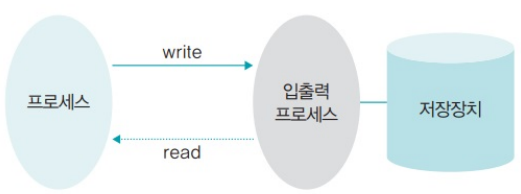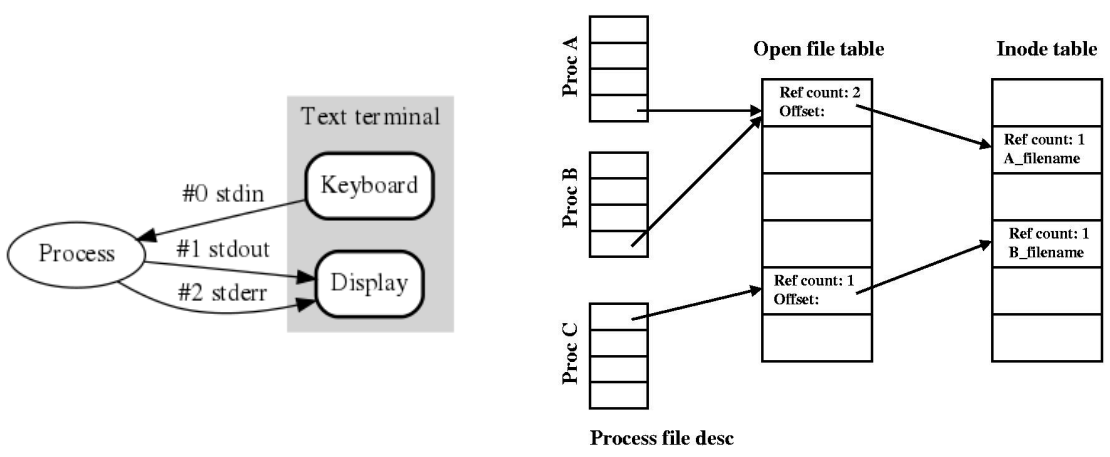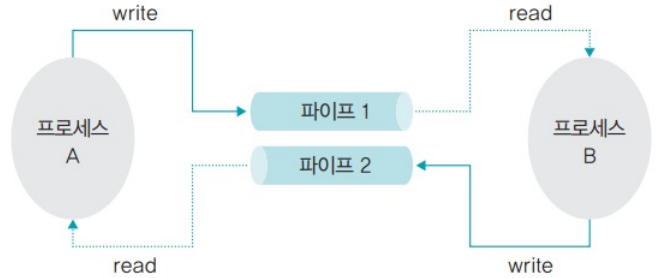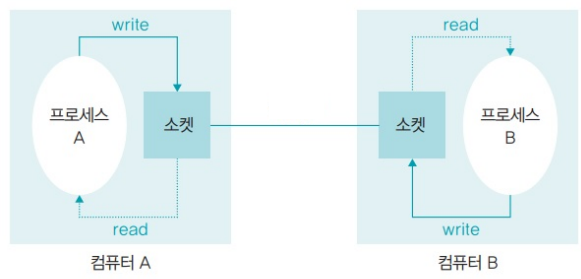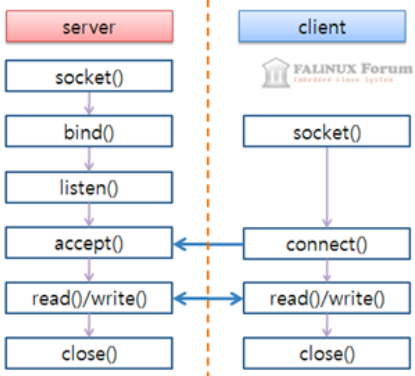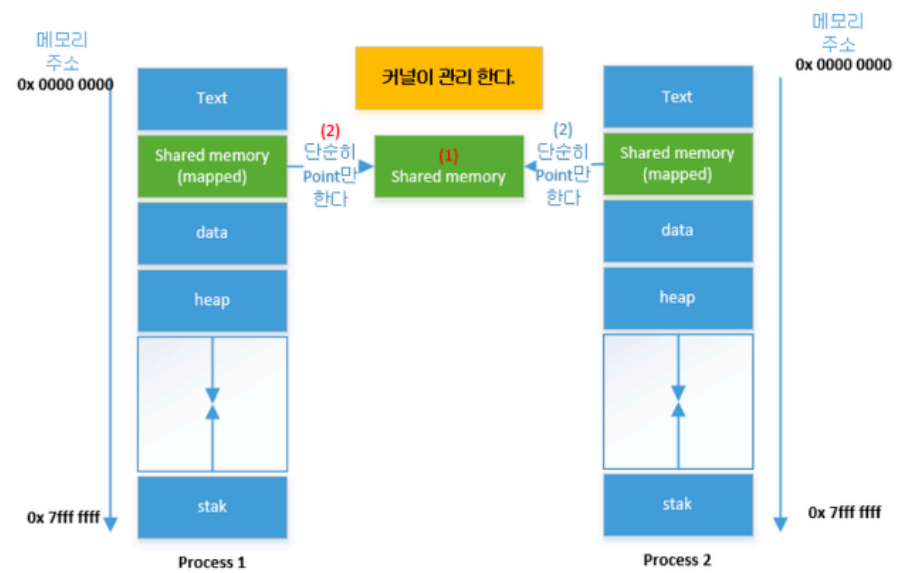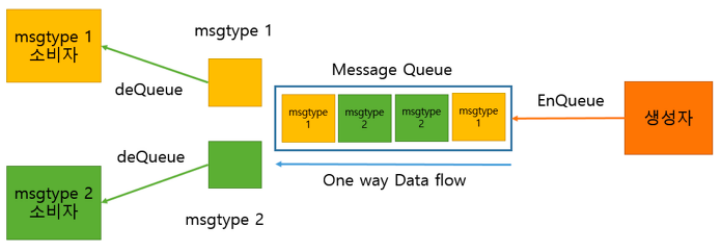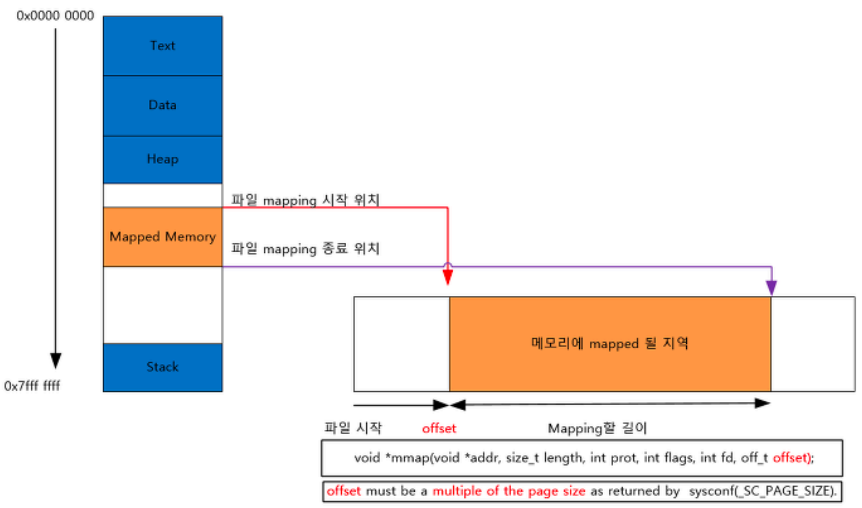1. 파일을 이용한 통신
1
2
3
4
5
6
7
8
9
10
11
12
13
14
15
16
| #include <stdio.h>
#include <unistd.h>
#include <fcntl.h>
int main()
{
int fd;
char buf[124]={0,};
fd = open("temp.txt", O_RDWR);
write(fd, "Test", 5);
lseek(fd,0,SEEK_SET);
read(fd, buf, 5);
printf(buf);
close(fd);
return 0;
}
|
파일 입출력 연산
2. 파일 디스크립터를 이용한 통신
- 프로세스끼리 파일 디스크립터를 공유해서 사용한다.
1
2
3
4
5
6
7
8
9
10
11
12
13
14
15
16
17
18
19
20
21
22
23
24
25
26
27
28
29
30
31
| #include <fcntl.h>
#include <stdio.h>
#include <unistd.h>
int global = 100; // 부모-자식 간 공유되지 않는다.
int main() {
char str[128] = {
0,
};
int fd = open("temp.txt", O_RDWR); // 부모 자식이 동시에 파일을 공유한다!
pid_t pid;
pid = fork();
if (pid > 0) { // parent
write(fd, "Can you hear me?", 17);
sleep(2);
lseek(fd, 17, SEEK_SET);
read(fd, str, 12);
printf("parent(%X): %s \n", getpid(), str);
close(fd);
} else if (pid == 0) { // child
sleep(1); // 타이밍을 맞추기 위한(동기화를 위한) 방법
lseek(fd, 0, SEEK_SET);
read(fd, str, 17);
printf("child(%X): %s \n", getpid(), str);
write(fd, "Yes, I can!", 12);
}
return 0;
}
|
간혹 전역변수를 통해 부모-자식 간 통신을 구현하려고 할 수 있는데, 프로세스간에는 메모리를 공유하지 않으므로 불가능하다!
2.1. 파일 디스크립터
프로세스가 파일을 다룰 때 사용하는 개념으로 0 이상의 정수값으로 표현된다. 운영체제가 특정 파일에 할당해주는 값으로, 시스템 함수 open(), read(), write() 등에서 작업을 처리하기 위한 값이다.
파일 디스크립터 값은 프로세스마다 별개이다. 프로세스는 자기만의 파일 디스크립터 테이블을 하나씩 자기고 있기 때문이다. 이 테이블을 File Descriptor Table라 하며, 이 배열의 index가 바로 파일 디스크립터 값이다.
- 예시:
A.txt, B.txt, 프로세스 C, 프로세스 D가 있을 때A.txt를 가리키는 디스크립터 값이 프로세스 C와 D에서 서로 다를 수 있다.- 프로세스 C에서
A.txt를 가리키는 디스크립터 값, 프로세스 D에서 B.txt를 가리키는 디스크립터 값이 서로 같을 수 있다.
open() 이외에 파일 디스크립터를 생성하는 함수가 더 있는데 아래와 같은 함수들이 파일 디스크립터를 새로 생성한다.
open(), creat()(오타가 아니라 실제 함수 이름이다!), socket(), accept(), pipe() 등
File descriptor 예
2.1.1. Open file table
- 프로세스에 의해 open된 파일의 입출력 동작을 지원하기 위한 테이블
- 테이블 자체는 커널이 단 하나를 생성하며, 모든 프로세스가 접근할 수 있게 공유되어 있다.
- 파일이 열릴 때마다 entry(테이블의 행)가 하나씩 할당된다.
- 각 엔트리에는 아래와 같은 내용을 담고 있다.
- 파일 위치 지시자(File Offset): 입출력 작업이 진행되는 위치
- 파일 상태 플래그(File Status Flags)
- 참조 카운터(Reference Count): 해당 파일을 참조하는 파일 디스크립터의 개수
- 파일의 inode 정보: 파일 시스템 내 파일을 식별하는 inode에 대한 포인터
- 같은 프로세스에서 동일 파일을 3번
open하면 새 엔트리가 3개가 생성된다. - 다른 프로세스에서 동일 파일을
open해도 새 엔트리가 생성된다.- 위 두 가지 경우 모두 엔트리의 ref count는 1이다.
1
2
3
4
5
6
7
8
| //fd1, fd2, fd3은 모두 다른 값
//엔트리 생성, ref count: 1
int fd1 = open("fileA.txt", O_RDONLY);
//별도의 엔트리 또 생성 (2개째), ref count: 1
int fd2 = open("fileA.txt", O_RDONLY);
//또 엔트리 생성 (3개째), ref count: 1
int fd3 = open("fileA.txt", O_RDONLY);
|
fork나 dup 함수를 사용하는 경우 새 엔트리가 생성되지 않으며, 새로 만들어진 파일 디스크립터는 기존의 엔트리를 참조하게 된다. 그리고 기존 엔트리의 Ref Count가 1이 증가한다.
1
2
3
4
5
6
| //fd1과 fd2 값은 같음
// open file table 엔트리 생성, ref count = 1
int fd1 = open("fileA.txt", O_RDONLY);
// 동일 open file table 엔트리, ref count = 2
int fd2 = dup(fd1);
|
1
2
3
4
5
6
| // open file table 엔트리 생성, ref count = 1
int fd1 = open("fileA.txt", O_RDONLY);
if (fork() == 0) {
// 자식 프로세스
// fd1은 부모와 동일한 open file table 엔트리를 가리킴, ref count = 2
}
|
2.1.2. 예약된 파일 디스크립터
- 파일 디스크립터 값 중 0, 1, 2는 미리 예약되어 있으며, 각각 다음의 의미를 가진다.
- 0:
stdin- standard input(표준 입력)
- 프로그램에 대한 입력을 나타내는 stream
- 일반적으로 키보드에 해당됨
- 1:
stdout- standard output(표준 출력)
- 출력을 위한 stream
- 현재 shell을 실행한 console이나 terminal에 해당됨
- 2:
stderr- standard error(표준 오류)
- 디버깅 정보, 에러를 출력하는 데 사용됨
- 예시
1
2
3
4
5
6
7
8
9
10
11
12
13
| #include <fcntl.h>
#include <stdio.h>
#include <unistd.h>
int main() {
char buf[124] = {};
int fd = open("temp.txt", O_RDWR);
printf("fd: %d \n", fd); // 출력값은? 3
write(fd, "Test", 5);
lseek(fd, 0, SEEK_SET);
}
|
2.1.3. Redirect 연산
위의 예시 std_fd_ex.c을 컴파일한 프로그램 이름이 program일 때, ./program 3> temp.txt 명령으로 실행하면 fd 값이 4가 된다.
3> temp.txt : 3번 파일 디스크립터를 temp.txt에 할당하라는 뜻이다.- 3번 파일 디스크립터를 redirect로 연 후 시작하므로, fd의 값은 4가 나오게 된다.
3. 파이프를 이용한 통신
파이프(pipe)란 데이터 스트림을 한 프로그램에서 다른 프로그램으로 전달하는 메커니즘으로, 유닉스 계열 OS에서 제공하는 동기화 통신 방식이며 | 기호로 흔히 표현된다.
파이프에 쓰기 연산을 하면 데이터가 전송되고, 읽기 연산을 하면 데이터를 받을 수 있어 단방향 통신이라고 할 수 있다.
- 0번: 읽기, 1번: 쓰기
- 예:
ls | grep passed - ls의 출력 결과를 grep 명령어로 전달 - 파일 입출력과 같이
open() 함수로 Pipe descriptor를 열고 작업을 한 후 close() 함수로 마무리한다.
파이프를 이용한 통신
예시
1
2
3
4
5
6
7
8
9
10
11
12
13
14
15
16
17
18
19
20
21
22
23
24
25
26
27
28
29
30
31
32
33
34
35
36
37
| #include <stdio.h>
#include <stdlib.h>
#include <string.h>
#include <unistd.h> //pipe 사용 위함
#include <pthread.h>
int main(){
int pipefd[2]; // [0] for read, [1] for write
pid_t pid;
char buf[128];
// function signature: int pipe(int pipefd[2]);
// 주의! pipe()를 이용한 통신은 부모-자식 간 프로세스 관계에서만 가능함
if(pipe(pipefd) < 0){
printf("pipe error\n");
return 1;
}
pid = fork();
if(pid > 0){ //parent process
close(pipefd[0]);
strcpy(buf, "Hello?\n");
//부모에서 쓰기용 [1] 파이프에 데이터 기록
write(pipefd[1], buf, strlen(buf));
}
else if(pid == 0) { //child process
close(pipefd[1]);
//자식에서 읽기용 [0] 파이프에서 데이터 읽음
read(pipefd[0], buf, 128);
printf(">> I am child! I can hear the parent!!: %s\n",buf);
}
else {
printf("fork error\n");
}
return 0;
}
|
- 자식이 부모에게 역으로 데이터를 전달하려면 어떻게 해야 할까?
- 파이프를 하나 더 만들면 된다.
pipeA[0], pipeB[1]를 각각 부모의 읽기/쓰기 파이프로 사용하고 pipeA[1], pipeB[0]를 각각 자식의 쓰기/읽기 파이프로 사용하자.
pipe()를 이용한 통신은 부모-자식 간 프로세스에서만 가능하다! 아무 관련 없는 프로세스끼리 파이프 통신을 하기 위해선 아래에서 설명할 FIFO를 사용해야 한다.
3.1. 파이프의 종류
- 이름 없는 파이프
- 일반적으로 파이프라고 하면 이름 없는 파이프를 가리킨다.
- 이름 있는 파이프(명명 파이프, Named Pipe, FIFO)
- FIFO라 불리는 특수 파일을 이용한다.
- 서로 관련 없는 프로세스 간 통신에 사용한다.
- 차이점
- pipe는 열려져 있는 pipe에 대해서는 open할 수 없지만, FIFO는 가능하다.
- 즉, FIFO는 서로 다른 (부모자식이 아닌) process간에 data를 주고받을 수 있다(
pipe()는 주고받지 못한다).
- pipe는 파일시스템에 이미지를 생성하지 않는 반면에 FIFO는 파일 시스템상에 이미지를 가진다.
FIFO 예시: Receive
1
2
3
4
5
6
7
8
9
10
11
12
13
14
15
16
17
18
19
20
21
22
23
24
25
26
27
28
29
| #include <stdio.h>
#include <stdlib.h>
#include <string.h>
#include <fcntl.h>
#include <unistd.h>
#include <sys/types.h>
#include <sys/stat.h>
int main() {
int counter = 0;
int fd;
char buff[128];
if ( mkfifo("temp.txt", 0666) < 0){
perror( "mkfifo() error");
return 1;
}
fd = open("temp.txt", O_RDWR);
// <- why RW? (NOT O_RDONLY?) It's for both read and write access.
// RDONLY(읽기 권한)만 주면 쓰레기 값을 계속 읽는다.
// 쓰기 권한을 같이 줌으로써 reference count를 1을 부여해 read()에서 blocking의 효과를 부여한다.
while(1){
memset( buff, 0, 128);
read(fd, buff, 128); //읽기권한만 주면 파이프에 아무 것도 없으면 스킵되므로, 무한반복이 됨
printf( "%d: %s\n", counter++, buff);
}
close(fd);
}
|
FIFO 예시: Sender
1
2
3
4
5
6
7
8
9
10
11
12
13
14
| #include <stdio.h>
#include <stdlib.h>
#include <string.h>
#include <fcntl.h>
#include <unistd.h>
int main( void)
{
int fd;
char *str = "I am the sender!";
fd = open("temp.txt", O_WRONLY);
write(fd, str, strlen(str));
close(fd);
}
|
위 두 프로그램 실행 시 temp.txt가 만들어지는데, ls -al으로 확인하면 파일 타입이 p인 것을 확인할 수 있다. 이 상태에서 echo "hello" > temp.txt 를 실행하면 파이프로 데이터를 밀어넣는 것이 된다.
FIFO 예시
4. 소켓을 이용한 통신
소켓 프로그래밍은 일종의 네트워크 프로그래밍(Server/Client)으로, 서로 다른 컴퓨터가 각각 서버-클라이언트가 되어 각 컴퓨터의 프로세스끼리 통신하는 방법이다.
소켓 통신을 하고자 하는 프로세스는 자신의 소켓과 상대방의 소켓을 연결해야 한다. 운영체제 함수를 이용하여 시스템에 있는 프로세스가 소켓을 바인딩하게 한 후 소켓에 쓰기 연산을 하면 데이터가 전송되고, 읽기 연산을 하면 데이터를 받게 된다. 소켓 통신에 필요한 함수 호출 흐름을 아주 간략히 하면 아래와 같다.
socket(): 소켓 생성bind(): 주소 할당listen(): 통신 요청을 기다림connect(): 통신 요청accept(): 통신 수락read()/write(): 통신close(): 소켓 종료
소켓을 이용한 통신: 도식
소켓을 이용한 통신: API 호출 흐름도
예시: Server
1
2
3
4
5
6
7
8
9
10
11
12
13
14
15
16
17
18
19
20
21
22
23
24
25
26
27
28
29
30
31
32
33
34
35
36
37
38
39
40
41
42
43
44
45
46
47
| #include <string.h>
#include <stdio.h>
#include <stdlib.h>
#include <unistd.h>
#include <sys/types.h>
#include <sys/socket.h>
#include <netinet/tcp.h>
#include <arpa/inet.h>
//#include "sock.h"
int main() {
char buffer[256];
char buffer2[256];
int fd = socket(AF_INET, SOCK_STREAM, 0);
if (fd < 0) return -1;
struct sockaddr_in saddr;
memset(&saddr, 0, sizeof(saddr));
saddr.sin_family = AF_INET;
saddr.sin_addr.s_addr = htonl(INADDR_ANY);
saddr.sin_port = htons(7777); // port number
// open a server
if (bind(fd, (struct sockaddr *) &saddr, sizeof(saddr)) < 0)
return -1;
if (listen(fd, 16) < 0)
return -1;
while (1) {
struct sockaddr_in caddr;
int len = sizeof(caddr);
int client_fd = accept(fd, (struct sockaddr*) &caddr, &len);
if (client_fd < 0) continue;
// read from client
memset(buffer, 0, sizeof(buffer));
read(client_fd, buffer, sizeof(buffer));
printf(buffer);
sprintf(buffer2, "I got you!: %s", buffer);
write(client_fd, buffer2, strlen(buffer2));
close(client_fd);
}
return 0;
}
|
예시: Client
1
2
3
4
5
6
7
8
9
10
11
12
13
14
15
16
17
18
19
20
21
22
23
24
25
26
27
28
29
30
31
32
33
34
35
36
37
38
39
40
| #include <string.h>
#include <stdio.h>
#include <stdlib.h>
#include <unistd.h>
#include <sys/types.h>
#include <sys/socket.h>
#include <arpa/inet.h>
#include <netinet/in.h>
#include <netinet/tcp.h>
#include <netdb.h>
int main() {
char buffer[256];
int sockfd = socket(AF_INET, SOCK_STREAM, 0);
if (sockfd < 0) return -1;
struct hostent* hptr = gethostbyname("127.0.0.1");
if (hptr->h_addrtype != AF_INET) return -1;
struct sockaddr_in saddr;
memset(&saddr, 0, sizeof(saddr));
saddr.sin_family = AF_INET;
saddr.sin_addr.s_addr =
((struct in_addr*) hptr->h_addr_list[0])->s_addr;
saddr.sin_port = htons(7777); // port number
// connect to the server
if (connect(sockfd, (struct sockaddr*) &saddr, sizeof(saddr)) < 0)
return -1;
char *msg = "This is a socket communication!!";
write(sockfd, msg, strlen(msg));
memset(buffer, 0, sizeof(buffer));
read(sockfd, buffer, sizeof(buffer));
printf(buffer);
close(sockfd);
return 0;
}
|
5. Shared memory를 이용한 통신
커널이 관리하는 일정한 크기의 공유 메모리 공간(Shared memory)을 통해 통신하는 방법으로, Shared memory는 마치 힙 메모리를 읽듯이 접근 및 사용할 수 있다. 이 방법은 아래와 같은 특징이 있다.
- IPC 방법 중 가장 속도가 빠름
- 사용하려는 프로세스간 할당한 크기가 동일해야 사용 가능
- 동기화가 중요한 포인트로, 신경써야 할 부분
Shared memory를 이용한 통신
5.1. 사용되는 함수
int shmget(key, size, flag): shared memory get- 공유 메모리를 생성하거나 접근하기 위한 함수
- key: 공유 메모리 할당 및 접근하기 위한 고유한 키 값, 커널에서 관리됨
- key가 지시하는 메모리 공간에 이미 공유 메모리 세그먼트가 생성되어 있으면 그 공간의 id를 반환하고, 없으면 새 공간 생성하여 id를 반환한다.
- size: 새로 할당할 공유 메모리의 최소 크기
- 이미 할당된 메모리에 접근할 땐 0으로 입력받는다.
- flag: 함수 동작 관련 플래그,
IPC_CREAT, IPC_EXCL을 사용할 수 있음 - return: key에 해당하는 공유 메모리의 id
void* shmat(shmid, shmaddr, flag): shared memory attach- 공유 메모리를 프로세스에서 사용할 수 있게 하는 함수
- shmid:
shmget()으로 얻은 id - shmaddr: 공유 메모리가 붙을 주소
NULL로 지정시 시스템은 적절한 주소에 주소를 붙인다.
- return: 붙은 공유 메모리의 주소로 힙 메모리(
malloc() 반환값)처럼 사용하면 됨
void* shmctl(shmid, cmd, buf): shared memory control- 공유 메모리를 제어하기 위한 함수
- shmid:
shmget()으로 얻은 id - cmd: 공유 메모리를 제어하기 위한 command
- IPC_RMID: 공유 메모리 공간을 삭제했다고 표시하는 명령어. 그러나 바로 삭제되지는 않고, 공유 메모리에 attach했던 모든 프로세스가 detach하는 순간 삭제됨
- return: 작업 성공 시 0을 반환
예시: Write
1
2
3
4
5
6
7
8
9
10
11
12
13
14
15
16
17
18
19
20
21
22
23
24
25
| #include <stdio.h>
#include <stdlib.h>
#include <string.h>
#include <sys/ipc.h>
#include <sys/shm.h>
#include <unistd.h>
int main() {
int shmid = 0;
char *shared_memory = 0;
// get shared memory
shmid = shmget((key_t)7777, 128, 0666 | IPC_CREAT);
if (shmid == -1) return -1;
// attach to the shared memory
shared_memory = (char *)shmat(shmid, (void *)0, 0);
if (shared_memory == -1) return -1;
while (1) {
strcpy(shared_memory, "Hello?\n");
sleep(1);
strcpy(shared_memory, "Can you hear me?\n");
sleep(1);
}
}
|
예시: Read
1
2
3
4
5
6
7
8
9
10
11
12
13
14
15
16
17
18
19
20
21
22
23
24
| #include <stdio.h>
#include <stdlib.h>
#include <string.h>
#include <sys/ipc.h>
#include <sys/shm.h>
#include <unistd.h>
int main() {
int shmid;
char *shared_memory = 0;
// get shared memory
shmid = shmget((key_t)7777, 128, 0666 | IPC_CREAT);
if (shmid == -1) return -1;
// attach to the shared memory
shared_memory = (char *)shmat(shmid, (void *)0, 0666 | IPC_CREAT);
if (shared_memory == -1) return -1;
while (1) {
printf(shared_memory);
sleep(1);
}
}
|
예시: Clear
Shared memory는 프로세스와 관계없이 커널에서 만들어지기 때문에 프로그램을 닫아도 유지된다. 즉 Memory Leak이 발생할 수 있으므로 따로 Clear를 위한 코드를 실행해야 한다.
1
2
3
4
5
6
7
8
9
10
11
12
13
14
15
16
17
18
19
| #include <stdio.h>
#include <stdlib.h>
#include <string.h>
#include <sys/ipc.h>
#include <sys/shm.h>
#include <unistd.h>
int main() {
int shmid;
char *buff = NULL;
void *shared_memory = (void *)0;
// get shared memory
shmid = shmget((key_t)7777, 128, 0666 | IPC_CREAT);
if (shmid == -1) return -1;
printf("%X \n", shmctl(shmid, IPC_RMID, 0));
}
|
5.2. 단점
동기화가 되어 있긴 하지만 다른 프로세스는 메모리에 쓰인 값이 언제 쓰인 것인지 알 수 없다. 즉 쓰인 값이 기존 값인지 새 값인지 알 수 없다.
6. Message queue를 이용한 통신
- 일종의 파이프로, 커널 메모리 공간을 활용한다.
- 구조체를 기반으로 작동하므로 메세지 경계가 명확하다.
- block 단위임(파이프는 stream으로 경계가 명확하지 않음)
- 동기화를 고려할 필요가 없다.
- 데이터가 기존 데이터인지 새 데이터인지 식별이 가능하다.
Message queue를 이용한 통신
예시: Sender
1
2
3
4
5
6
7
8
9
10
11
12
13
14
15
16
17
18
19
20
21
22
23
24
25
26
27
28
29
| #include <stdio.h>
#include <string.h>
#include <sys/ipc.h>
#include <sys/msg.h>
#include <sys/stat.h>
#include <sys/types.h>
#include <unistd.h>
struct msgbuf {
long mtype; /* message type, must be > 0 */
char mtext[128]; /* message data */
};
int main() {
key_t key_id;
struct msgbuf msg = { 5, { 0, } }; // type, text
// Message Queue
key_id = msgget((key_t)7777, IPC_CREAT | 0666);
if (key_id == -1) return -1;
while (1) {
strcpy(msg.mtext, "This is MQ!\n");
msgsnd(key_id, &msg, sizeof(struct msgbuf), IPC_NOWAIT);
sleep(1);
strcpy(msg.mtext, "Wow~~!!\n");
msgsnd(key_id, &msg, sizeof(struct msgbuf), IPC_NOWAIT);
sleep(1);
}
return 0;
}
|
예시: Receiver
1
2
3
4
5
6
7
8
9
10
11
12
13
14
15
16
17
18
19
20
21
22
| #include <stdio.h>
#include <sys/ipc.h>
#include <sys/msg.h>
#include <sys/stat.h>
#include <sys/types.h>
struct msgbuf {
long mtype; /* message type, must be > 0 */
char mtext[128]; /* message data */
};
int main() {
key_t key_id;
struct msgbuf msg;
key_id = msgget(7777, IPC_CREAT | 0666);
if (key_id < 0) return -1;
while (1) {
msgrcv(key_id, &msg, sizeof(struct msgbuf), 5, 0);
printf("%s", msg.mtext);
}
return 0;
}
|
7. Memory map을 이용한 통신
- 파일을 프로세스의 메모리의 특정 부분에 일정 부분 맵핑시켜 사용한다.
- Shared Memory와 마찬가지로 메모리를 공유한다는 측면에 있어서는 서로 비슷하나, Memory Map의 경우 열린 파일을 메모리에 맵핑시켜서 공유한다는 점이 차이가 있다.
- 파일로 대용량 데이터를 공유 할 때 유리하며, 메모리에 맵핑된 파일을 읽거나 쓰면
read() 나 write() 시스템 콜을 사용할 때 발생하는 불필요한 복사를 방지한다.- 추가적인 복사는 사용자 영역의 버퍼로 데이터를 읽고 써야 하기 때문에 발생함
- mmap 함수의 종류는 많다.
Memory map을 이용한 통신
예시: Sender
1
2
3
4
5
6
7
8
9
10
11
12
13
14
15
16
17
18
19
20
21
22
23
24
25
26
27
28
29
30
31
32
33
| #include <errno.h>
#include <fcntl.h>
#include <stdio.h>
#include <stdlib.h>
#include <string.h>
#include <sys/mman.h>
#include <sys/stat.h>
#include <sys/types.h>
#include <unistd.h>
int main() {
int fd;
char *file = NULL;
struct stat sb;
int flag = PROT_WRITE | PROT_READ;
fd = open("temp.txt", O_RDWR | O_CREAT);
if (fstat(fd, &sb) < 0) return -1;
file = (char *)mmap(0, 40, PROT_WRITE | PROT_READ, MAP_SHARED, fd, 0);
while (1) {
strcpy(file, "This is the memory map!\n");
sleep(1);
strcpy(file, "wow!!\n");
sleep(1);
};
munmap(file, 40);
close(fd);
return 0;
}
|
예시: Receiver
1
2
3
4
5
6
7
8
9
10
11
12
13
14
15
16
17
18
19
20
21
22
23
24
25
26
27
28
29
| #include <errno.h>
#include <fcntl.h>
#include <stdio.h>
#include <stdlib.h>
#include <string.h>
#include <sys/mman.h>
#include <sys/stat.h>
#include <sys/types.h>
#include <unistd.h>
int main() {
int fd;
char *file = NULL;
struct stat sb;
int flag = PROT_WRITE | PROT_READ;
fd = open("temp.txt", O_RDWR | O_CREAT);
if (fstat(fd, &sb) < 0) return -1;
file = (char *)mmap(0, 40, PROT_WRITE | PROT_READ, MAP_SHARED, fd, 0);
while (1) {
printf("%s", file);
sleep(1);
}
munmap(file, 40);
close(fd);
return 0;
}
|
8. IPC 방법 정리
| IPC 종류 | 사용 시기 | 공유 매개체 | 통신 단위 | 통신 방향 | 통신 가능 범위 |
|---|
| PIPE | 부모 자식 간 단방향 통신 시 | 파일 | Stream | 단방향 | 동일 시스템 |
| Named PIPE | 다른 프로세스와 단방향 통신 시 | 파일 | Stream | 단방향 | 동일 시스템 |
| Mesage Queue | 다른 프로세스와 단방향 통신 시 | 메모리 | 구조체 | 단방향 | 동일 시스템 |
| Shared Memory | 다른 프로세스와 양방향 통신 시 | 메모리 | 구조체 | 양방향 | 동일 시스템 |
| Memory Map | 다른 프로세스와 양방향 통신 시 | 파일+메모리 | 페이지 | 양방향 | 동일 시스템 |
| Socket | 다른 시스템간 양방향 통신 시 | 소켓 | Stream(Packet) | 양방향 | 동일 + 외부 시스템 |
